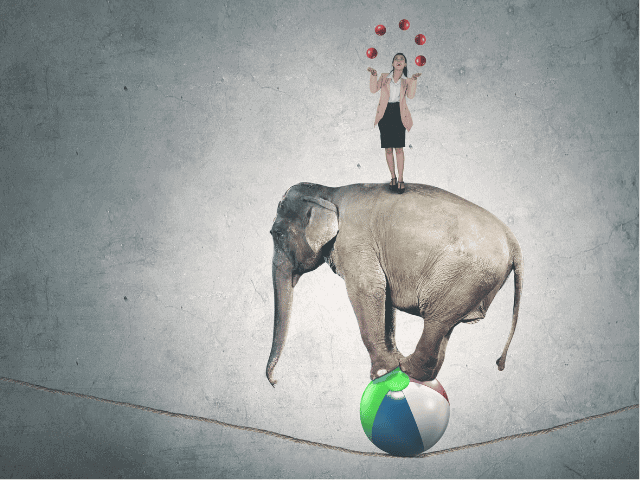
by Ola ElKhatib
Ever wondered why teaching is often seen as a stressful profession? It’s a juggling act. On top of the demanding curriculum and administrative tasks, are the growing complexity of student needs. Each day, each class presents a unique mosaic as students arrive with their academic strengths and challenges, personal needs, and lived experiences.
In conversations with teachers, they often voice their concerns about the constant “DOING” that defines their profession. Phrases like, “There is always so much to do,” echo through the teacher’s lounge. No wonder that research shows that over 70% of teachers are stressed (Education Support, 2019, cited in Crome & Cise, 2020)! Similar conditions affect our students. It’s disheartening to see them gasping for breath as they attempt to navigate the whirlwind of school and life.
But this challenge also presents an opportunity in our educational spaces.
While we may not have the power to immediately ease the demands on our educational systems, we can bolster the people within these systems by casting a more focused light on our state of BEING while we’re in the thick of DOING.
Our state of BEING encompasses our emotions, anxieties, values, and motivations as we step into the classroom each day. Often, the stress we experience in demanding environments arises from the disconnection between our inner state and the external world. We know that when teacher well-BEING wanes, so too does student well-BEING.
There’s a subtle formula at our disposal, a formula that involves finding balance between “DOING” and “BEING” in our daily lives. Many of us habitually reside in the “DOING” state, continually striving to stay ahead of the day’s demands. However, even if we excel at this, there’s a toll on our well-BEING.
Having recently completed the Well-BEING Education course with The Well-BEING Distillery in Australia, I encountered numerous, easy to implement (DO) strategies to restore balance to our state of BEING.
Did you know that mindful breathing is the portal to BEING? How often do you notice your own breathing habits, or those of your students? What’s stopping you from DOING so? (The DOING of course!) This practice requires no lesson planning, no equipment, and no more than three minutes – even less – of your lesson time! Ironically, by taking time out of your DOING, it will increase your productivity. Moreover, it’s an invitation you can extend to everyone in the classroom.
One other technique stands out. It is called the “Empathy Upload.” It’s a simple practice that involves taking a moment to face each other in pairs and silently connect through eye contact and synchronized breathing. This practice calms the storm, fosters connection, and invites us to check in on one another. It helps us relax our bodily state and facial expressions and allows us to notice if someone needs a moment of support. By cueing our bodies for empathy, we create a space for everyone to reconnect with their best selves. This concept closely aligns with Drishti in the Yoga world, and it’s thrilling to integrate this ancient wisdom into our lessons effortlessly. No planning required!
As teachers, our role inherently involves tuning into the needs of individuals and the collective. Although this task may seem overwhelming, it’s a skill inherent in each of us. If we perceive it as a means of recentering ourselves first and foremost as a method of modeling this practice for the class, we unlock the potential to cultivate a classroom environment where all can flourish. In fact, you might consider granting students the agency to initiate “BEING check-ins” at any time. This practice can be followed by sharing, journaling or an art activity; extending the experience and nurturing connections even further.
Amidst the torrent of curriculum cascading into our classrooms, it’s up to us to strike a harmonious balance between the DOING and BEING of curriculum delivery. Rather than assessing learning outcomes in a rote manner and treating them like a checklist of things to get through, try using the curriculum to connect with the students’ BEING on a personal level. Ask them questions like, “Which part of the text resonated with you personally?” “What was your response when you read that?” Through these subtle shifts, we can transform the classroom narrative from one of relentless demands to moments of meaningful connection.
Putting the “BEING” state more in the forefront of teaching and learning has the power to nurture autonomy, agency, and trust and to create a space for connection, engagement, and belonging through the curriculum itself.
If this all sounds overwhelming and too much DOING to do, try baby steps. Take a few moments throughout your day to pause and ponder, “What does my ‘BEING’ state look and feel like?” and “How does it affect those around me?” If we expect students to master self-regulation, we must first embody and model the strategies they need to grasp.
And the next time you catch a glimpse of yourself in the mirror, indulge in a moment of self-empathy upload. It’s a small but powerful step towards achieving a healthier balance between DOING and BEING.
Ola ElKhatib is a seasoned educator passionate about transforming schools so that all can thrive. She is the founder of OlavatEd, an evidence-informed service provider that empowers stakeholders to balance personal and professional fulfillment as they achieve extraordinary performance standards without compromising overall wellbeing.
